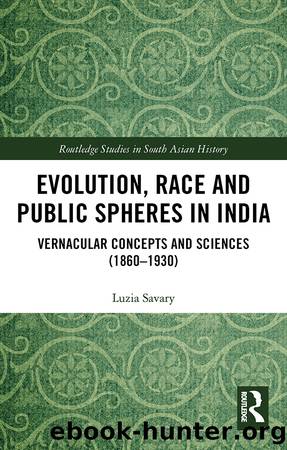Evolution, Race and Public Spheres in India by Luzia Savary

Author:Luzia Savary [Savary, Luzia]
Language: eng
Format: epub
Tags: Social Science, Regional Studies
ISBN: 9781351010061
Google: APaODwAAQBAJ
Publisher: Routledge
Published: 2019-03-27T03:46:29+00:00
The rest of Surajbhanuâs origin tale very much resembled Risleyâs: the Äryas subjugated the mlecchas but married their women and through this process the caste system had emerged. âDirectâ descendants of mlecchas could still be found in Indiaâs forests, and lived on hunting although, with respect to their ancestors, their decorum (tamÄ«z) had improved a lot: the Bhil constituted an example. Nevertheless, Surajbhanu suggested, everywhere in the world savagery was just a result of outer circumstances, it was not determined by race. The Indian Bhangs and Chamars provided an example, which was similar to the one of blacks in the US. They had become sepoys and fought in WWI, side by side with Kshatriyas, showing the same worth (jouhar) in battle. All these examples demonstrated that the human genre (manuá¹£ya mÄtr) was one and that all humans could do all kinds of works. Caste obstruction (vará¹a aur jÄti kÄ aá¸angÄ) was not grounded in nature (prakritik nahin hai).25 In the second part of his pamphlet Surajbhanu emphasized that Jains and Bhuddists had done a lot in the past to liberate the oppressed castes. He lamented the fact that even Jains themselves were disregarding their ÅÄstras, adopting several restrictions with regard to interaction with lower castes, and urged them to revert this tendency and spread the message of equality. In a later philosophical treatise, titled JÄ«van nirvÄh (1920), Surajbhanu contested the Darwinian principle of the âsurvival of the fittest.â This interpretative tool, he argued, might be appropriate for describing what went on in the animal world. It could also be applied to human behavior in âancient timesâ (prÄcÄ«n samay), when in places such as Africa and the Fiji Islands man had been eating his fellow beings, when the Aryan invaders of India had brutally subjugated the countryâs original inhabitants, or when, in more recent times, Europeans had enslaved âAfrican Negroesâ (ÄfrikÄ ke nÄ«grolog). But after that humans had learned civilization and started to act according to the principles of âcompassionâ (mahÄnubhÅ«ti) and equality (samÄntÄ). Step by step they have finally understood that the progress of the whole human genre was also in the interests of the individual.26 Surajbhanuâs approach to the caste question was in line with the binary division of the human continuum into civilized and uncivilized and the civilizing mission ideology expressed in the first two sections of this chapter. Also his race concept resonated with this view: it was malleable and grounded upon the pedagogical view of civilization. The equation of caste with race served him as a confirmation that civilization could be learned.
Be it in support of or against caste, the second group of authors prevalently employed the comparison between caste and race within a traditional argumentative framework. In traditional Hindu literature, post-Buddhist authors reflecting on the relationship between heredity and action (karma) often expressed the view that while a Åudra who perfectly performed the duty of his own caste (svadharma) could be considered ethically valuable, he would never attain the peculiar ethical potential that belongs only to the Brahman.
Download
This site does not store any files on its server. We only index and link to content provided by other sites. Please contact the content providers to delete copyright contents if any and email us, we'll remove relevant links or contents immediately.
Cecilia; Or, Memoirs of an Heiress — Volume 1 by Fanny Burney(32437)
Cecilia; Or, Memoirs of an Heiress — Volume 2 by Fanny Burney(31873)
Cecilia; Or, Memoirs of an Heiress — Volume 3 by Fanny Burney(31857)
The Great Music City by Andrea Baker(31488)
We're Going to Need More Wine by Gabrielle Union(18972)
All the Missing Girls by Megan Miranda(15585)
Pimp by Iceberg Slim(14397)
Bombshells: Glamour Girls of a Lifetime by Sullivan Steve(13977)
Talking to Strangers by Malcolm Gladwell(13227)
Norse Mythology by Gaiman Neil(13211)
Fifty Shades Freed by E L James(13158)
For the Love of Europe by Rick Steves(13049)
Mindhunter: Inside the FBI's Elite Serial Crime Unit by John E. Douglas & Mark Olshaker(9206)
Crazy Rich Asians by Kevin Kwan(9170)
The Lost Art of Listening by Michael P. Nichols(7411)
Enlightenment Now: The Case for Reason, Science, Humanism, and Progress by Steven Pinker(7239)
The Four Agreements by Don Miguel Ruiz(6636)
Bad Blood by John Carreyrou(6555)
Weapons of Math Destruction by Cathy O'Neil(6148)
